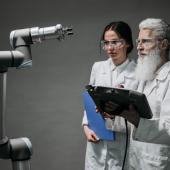The Dotcom Bust Nearly Killed This Silicon Valley Publisher, but Instead It Reinvented Its Business Model and Now It's Thriving
When Laura Baldwin arrived at O'Reilly Media in 2001 as Chief Financial Officer, she was well equipped for the job. She previously held the same position at Chronicle books and then spent a few years as a consultant for BMR & Associates, a firm that specializes in helping media companies.
The challenges at O'Reilly, however, were somewhat unique. Over the years the company had become something akin to the official publisher of Silicon Valley and had ridden the dotcom boom to prominence. Now that the boom had turned to bust, O'Reilly was in dire straits and banks were calling in loans.
So Baldwin did what a good CFO does, she instilled better financial management and within a few years the company had returned to profitability. However, she and the firm's founder, Tim O'Reilly, began to see an opportunity to truly transform the business. Today, as President, she sees a new model emerging that focuses not just on publishing books, but what comes after.
Humble Beginnings
Tim O'Reilly is an unusual tech icon. Soft spoken and understated, he's about as far from Steve Jobs or Elon Musk as you can imagine. In college he didn't major in engineering or physics, but classics. Nevertheless, he began working as a technical writer in the late 70s and within a few years started his business publishing manuals in a converted barn outside of Boston.
As the center of gravity in the technology industry shifted from Boston's Route 128 to the San Francisco Bay area in the late 80s, O'Reilly moved with it. The company soon became known for having a knack for identifying important technologies that were emerging and getting out reliable guides before anybody else.
So when the dotcom era began, O'Reilly and his company were at the center of it. Its products practically leapt off the shelves as eager entrepreneurs raced to keep up with the latest technologies and bring their products to market. Tim O'Reilly himself became something of a Silicon Valley oracle, with an almost uncanny ability to sense and articulate emerging trends.
That's what all came crashing down in 2000. With once high-flying startups dropping back down to earth, demand for O'Reilly books plummeted. In a painful restructuring, the company would lay off about a quarter of its staff. However, within a few years it would emerge again to help power the next technology boom.
O'Reilly 2.0
By 2003, O'Reilly saw a new era technology emerging. Called Web 2.0, a term that he and the company did much to popularize, it represented a shift from the Internet as mostly a collection of informational pages to a truly interactive software platform that would shift power from publishers to users.
Baldwin, named the company's Chief Operating Officer in 2004, saw the opportunity to shift the business along similar lines. With the company profitable again, it began to focus on building up its conference business with sponsorship emerging as a key revenue stream.
Now, rather than just merely publishing instruction manuals that explained how to use new technologies, O'Reilly emerged as a platform to help bring those technologies to the fore. At events with names like Web 2.0 Summit and OSCON, thought leaders would gather to meet and exchange ideas. Much like the web itself, the audience was becoming the product.
The success of the conference business would lead to an even greater shift that would not only lead to greater profits, but would redefine how it saw its role as a publisher.
From a Publishing Company to a Knowledge Evangelist
As O'Reilly saw its conference business grow, it also began to change the way it saw its business. Previously, its conferences focused on tech luminaries, like Jeff Bezos, Mary Meeker and Marc Andreessen, to get people excited about new technology trends. Yet it saw even greater opportunity in using conferences to help people leverage those new technologies.
"That shift in focus to the end user and asking ourselves 'What did they need to learn?' 'What tasks did they need to accomplish?'--that really drove our growth." Baldwin, now President of O'Reilly, told me. By 2014, the business was growing at the rapid rate of 45%
The company also saw another opportunity. Back in 1999, Tim O'Reilly had the foresight to partner with Pearson in a digital library. Baldwin saw the opportunity to transform that platform from what was essentially a reference library into a true learning platform. (Disclosure: I've been paid to appear on the O'Reilly's learning platform as an expert).
So O'Reilly bought out Pearson's share of the business and switched emphasis from one of selling individual books to a subscription model. The platform was also expanded to include online training courses, video events and other resources to help its customers meet the challenges of an ever-changing world. With 2.5 million users, it's now the fastest growing part of O'Reilly's business.
Gearing Up for the Next Great Disruption
Today, as the rest of the publishing industry struggles, O'Reilly is thriving. What's key to its success is that while other firms in the industry focus exclusively on sourcing and distributing books, O'Reilly's business is increasingly focused on what happens after the book is published by leveraging conferences and additional learning opportunities on the digital platform.
"We don't see ourselves as a book publisher," Baldwin says. "The book is just a container. What we're focused on now is packaging the knowledge and know-how of thought leading talent to help our customers make an impact on the world." That creates more value for O'Reilly's customers and also provides additional revenue for itself and its authors.
"So, for example, we might contract an author to write a book, but that relationship goes far beyond the publishing date," Baldwin explains. "They speak and do trainings at our conferences. They do events on our learning platform. They design online training curriculums. Anything that helps us spread knowledge so that it can be used productively."
Baldwin also feels confident that O'Reilly is well positioned for the next era of technology. "Our history has been rooted in the digital revolution, yet our future may not be," she says. "There are a number of technologies that are nascent today, from genomics to nanotechnology to new computing architectures like quantum. We see our job as spreading that knowledge, making it actionable and helping people navigate what's happening."
What could have been another cautionary tale of the excesses of the dotcom era has turned into an inspiring story of rebirth. The truth is that value never really disappears, it just shifts to another place.



